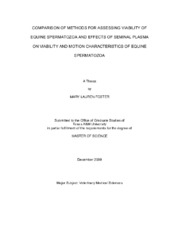| dc.contributor.advisor | Love, Charles C. | |
| dc.creator | Foster, Mary L. | |
| dc.date.accessioned | 2010-07-15T00:15:24Z | |
| dc.date.accessioned | 2010-07-23T21:46:21Z | |
| dc.date.available | 2010-07-15T00:15:24Z | |
| dc.date.available | 2010-07-23T21:46:21Z | |
| dc.date.created | 2009-12 | |
| dc.date.issued | 2010-07-14 | |
| dc.date.submitted | December 2009 | |
| dc.identifier.uri | https://hdl.handle.net/1969.1/ETD-TAMU-2009-12-7469 | |
| dc.description.abstract | Assessment of sperm viability is an important component for evaluating
stallion sperm quality. The flow cytometer is considered the standard in the
assessment of sperm plasma membrane integrity (viability); however, this
instrument is costly to purchase and use, and it requires an experienced
technician to operate it. The growing practice of assisted reproductive
technologies (ARTs) in the equine industry has increased the need for an
accurate but cost-effective means of determining sperm membrane viability.
The NucleoCounter® SP-100TM is reported to be an accurate, easy-to-perform,
and an efficient stallion-side test for sperm membrane viability.
To evaluate usefulness of the NucleoCounter® SP-100TM for assessing
sperm membrane integrity, neat semen was subjected to four treatments with
varying seminal plasma volumes and sperm concentrations. Sperm membrane
viability was assessed immediately, and at 24 and 48 hours after cooled-storage
using three methods: 1) flow cytometer utilizing the fluorescent vital stains SYBR-14/propidium iodide; 2) NucleoCounter® SP-100TM utilizing the
fluorescent vital stain propidium iodide; 3) eosin-nigrosin stained air-dried
smears of semen. Sperm motion characteristics (total and progressive motility)
were assessed using a computer assisted sperm motion analyzer (CASMA) and
results were compared to sperm membrane viability to determine the
relationship between sperm membrane viability and motion characteristics.
Results were compared statistically by: 1) analysis of variance (ANOVA); 2)
linear regression analysis; 3) coefficient of variation on untransformed and
transformed data (arc sine square root); and 3) the agreement of two
instruments, by means of which the difference between measurements of the
two instruments were plotted on the y-axis and the average of measurements
from the two instruments were plotted on the x-axis.
Results obtained with the NucleoCounter® SP-100TM agreed best with the
flow cytometer, and least with eosin-nigrosin staining. Coefficients of variation
were ≤ 5% for the three methods (transformed data). Sperm motion
characteristics and sperm viability were similar among treatments at Time 0. At
Times 24 and 48, sperm motion characteristics decreased at a more significant
rate compared to viability in the treatments containing ≥ 50% seminal plasma,
whereas differences among treatments were only significant at seminal plasma
concentrations above 50% when only sperm membrane viability was
considered. | en |
| dc.format.mimetype | application/pdf | |
| dc.language.iso | eng | |
| dc.subject | equine sperm | en |
| dc.subject | sperm membrane viability | en |
| dc.subject | NucleoCounter SP-100 | en |
| dc.subject | flow cytometery | en |
| dc.subject | eosin-nigrosin staining | en |
| dc.subject | sperm motility | en |
| dc.title | Comparison of Methods for Assessing Viability of Equine Spermatozoa and Effects of Seminal Plasma on Viability and Motion Characteristics of Equine Spermatozoa | en |
| dc.type | Book | en |
| dc.type | Thesis | en |
| thesis.degree.department | Veterinary Large Animal Clinical Sciences | en |
| thesis.degree.discipline | Veterinary Medical Sciences | en |
| thesis.degree.grantor | Texas A&M University | en |
| thesis.degree.name | Master of Science | en |
| thesis.degree.level | Masters | en |
| dc.contributor.committeeMember | Varner, Dickson D. | |
| dc.contributor.committeeMember | Hinrichs, Katrin | |
| dc.contributor.committeeMember | Blanchard, Terry L. | |
| dc.type.genre | Electronic Thesis | en |
| dc.type.material | text | en |


